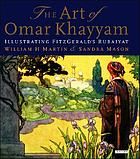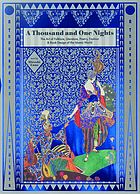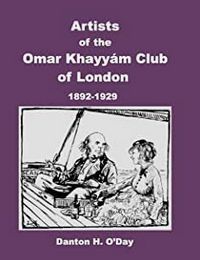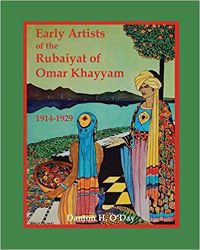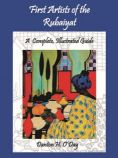Elihu Vedder’s conception of Edward Fitzgerald’s Rubaiyat of Omar Khayyam. Akela M. Nigrelli. University of Maryland at College Park, 1993. v, 304 p. Thesis research directed by Dept. of Art History and Archaeology.
Archives
The Art of Omar Khayyam. Illustrating FitzGerald’s Rubaiyat
The Art of Omar Khayyam. Illustrating FitzGerald’s Rubaiyat. William H. Martin & Sandra Mason. London : New York, Tauris, 2007. 184 p. Index. ISBN 978-84511-282-0
Summary:
“This book describes a phenomenon unique in publishing history: a book of poetry, published anonymously nearly 150 years ago – purporting to be the translation of an eleventh century Persian work – which has remained almost continuously in print and has stimulated at least 130 illustrators to try to illuminate the verses it contains.”
Infinite transformation: The modern craze over the Rubaiyat of Omar Khayyam in England and America, c. 1900-1930
Infinite transformation: The modern craze over the Rubaiyat of Omar Khayyam in England and America, c. 1900-1930. Michelle Kaiserlian. Proquest Dissertations and Theses, 2009. Illustrated. 374 p. ISBN: 9781109586534.
A Thousand and One Nights. The art of folklore, literature, poetry, fashion & book design of the Islamic world
A Thousand and One Nights. The art of folklore, literature, poetry, fashion & book design of the Islamic world. Hiroshi Unno. Tokyo, Pie Books, 2016. 295 p. ISBN: 978-4-7562-4816-9.
Summary:
Middle Eastern literature and poetry, including Arabian Nights and Rubaiyat of Omar Khayyam, has captured the imaginations of European people with its mysterious atmosphere and tales of exotic lands. From the 18th to the early 20th century, various European editions of these stories were published that included imaginative illustrations by notable European illustrators such as Nielsen, Dulac, Pogány, Bull and others. This book is a visual art collection of the world featured in such European illustrations and introduces the ancient Islamic manuscripts and art on which the illustrations are based. Text in Japanese, with an introduction and captions in English.
Artists of the Omar Khayyám Club of London 1892 to 1929
Artists of the Omar Khayyám Club of London 1892 to 1929. Danton O’Day. Emeritus Press, 2017. 86 p. ISBN: 9781389917240
Summary:
This book documents the menu artists of the Omar Khayyam Club of London from 1892-1929.
While 26 artists were credited in the two books of the Club, there actually were 28 different menu artists. Of these several were not properly credited for their contributions. For example, one artist was credited for three pictures that belonged to two other artists. Another incorrectly attributed picture was done by an, as yet, unidentified artist. This book details these issues as well as providing many other insights, firsts and interesting facts:
-First complete documentation of the artists of the Omar Khayyam Club of London Menus, 1892-1929
-First time most of the pictures have been seen since their initial publication
-Discovery of numerous incorrect artist credits
-Discovery of an “Unidentified Artist”
-Recognition of artists who were not credited for their contributions
-Corrected lists and timelines of artists and their contributions
-Learn about the artists: a cartoonist, a spy, the man who developed camouflage and more…
Early artists of the Rubaiyat of Omar Khayyam, 1914-1929
Early artists of the Rubaiyat of Omar Khayyam, 1914-1929. Danton O’Day. Emeritus Press, 2018. iv, 141 p. ISBN: 9781388734190.
Summary:
This intensely illustrated book focuses on the era from 1914-1929 that followed the Golden Age of Rubáiyát Art, 1884-1913. It reveals the work of 16 illustrators who produced two or more pictures to illustrate the poems and 9 other artists who embellished the poetry with page decorations, title page adornments and unique frontispiece images.
In these pages, the identity of a previously anonymous artist is revealed. New decorators are discovered. Tables and graphic timelines put all the work into perspective as multiple images—many published here for the first time in 90-100 years—reveal the often-unparalleled talent of artists who took their pens, inks and paints to the task of illustrating FitzGerald’s Rubáiyát.
First Artists of the Rubaiyat
First Artists of the Rubaiyat : A Complete Illustrated Guide. Danton O’Day. Emeritus Press, 2022. vi, 212 p. ISBN: 979-8-21-032614-0
Summary:
The book is a complete catalog of early artists of Edward FitzGerald’s Rubaiyat of Omar Khayyam and it offers a cornucopia of visual delights and discoveries. Hundreds of pictures by over 200 artists: photographs, oil paintings, watercolours, etchings, woodcuts, line drawings, calligraphy provide unique insight into the poetry and add beauty to one of the world’s most popular collections of verse. Many new artists are revealed with dozens of women artists identified.
